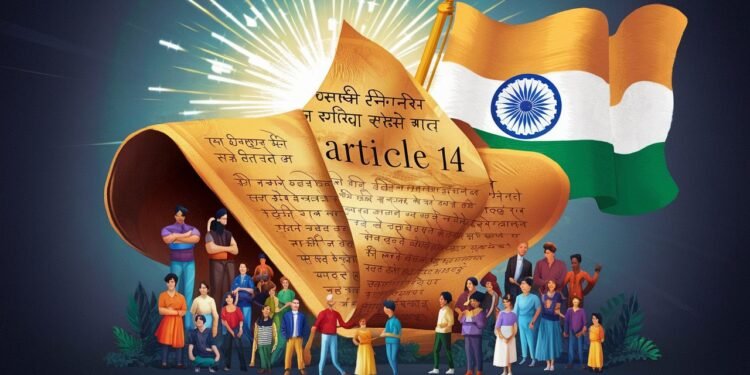Om Narendra Singh, B.Com LL.B,Lloyd School of Law
Introduction:
Article 14 of the Indian Constitution stands as a sentinel of equality, promising every person equality before the law and equal protection of the laws. This fundamental right has been a powerful instrument in shaping India’s legal landscape, challenging discriminatory practices, and promoting social justice. This article explores the dynamic interpretation of Article 14 by Indian courts, its application in various spheres of life, and its role in addressing contemporary challenges.
The Evolution of Article 14 Interpretation:
- From Formal to Substantive Equality: The interpretation of Article 14 has evolved from ensuring mere formal equality to striving for substantive equality. In E.V. Chinnaiah v. State of Andhra Pradesh (2005), the Supreme Court emphasized that the aim of Article 14 is not just equality of treatment but equality of results.
- The New Doctrine of Equality: In Navtej Singh Johar v. Union of India (2018), the Supreme Court articulated a new doctrine of equality, emphasizing that Article 14 includes within its fold the principle of non-discrimination on the ground of sexual orientation.
- Manifest Arbitrariness: The doctrine of manifest arbitrariness, introduced in Shayara Bano v. Union of India (2017), has become a powerful tool to strike down laws that are capricious, irrational, or without adequate determining principle.
Application in Various Spheres:
- Gender Justice: Article 14 has been instrumental in advancing gender equality. In Joseph Shine v. Union of India (2018), the Supreme Court struck down Section 497 of the Indian Penal Code (adultery law) as unconstitutional, holding it violated Article 14 by treating women as property of their husbands.
- LGBTQ+ Rights: The landmark judgment in Navtej Singh Johar v. Union of India (2018) decriminalized consensual same-sex relations, relying heavily on Article 14 to strike down Section 377 of the Indian Penal Code.
- Economic Rights: In Indian Hotel and Restaurant Association v. State of Maharashtra (2019), the Supreme Court upheld the right of women to work as bar dancers, striking down a state law that prohibited dance performances in bars as violative of Article 14.
- Environmental Justice: Article 14 has been invoked in environmental cases to ensure equal protection of the right to a clean environment. In M.C. Mehta v. Union of India (2018), dealing with air pollution in Delhi-NCR, the court emphasized the need for equal application of environmental norms to all citizens.
- Rights of Persons with Disabilities: In Vikash Kumar v. UPSC (2021), the Supreme Court interpreted Article 14 to hold that persons with disabilities have a right to reasonable accommodation in public employment.
Recent Case Laws:
- Jindal Stainless Ltd. v. State of Haryana (2017): The Supreme Court used Article 14 to strike down the levy of entry tax by states on goods imported from other states, promoting the concept of a common market across India.
- Abhiram Singh v. C.D. Commachen (2017): The court interpreted Section 123(3) of the Representation of the People Act, 1951 in light of Article 14, holding that an appeal for votes on the ground of religion, race, caste, community or language would amount to a corrupt practice.
- Anuj Garg v. Hotel Association of India (2007): The court struck down Section 30 of the Punjab Excise Act, 1914, which prohibited employment of women in premises where liquor is consumed by the public, as violative of Articles 14, 15, and 19.
- National Legal Services Authority v. Union of India (2014): The court recognized transgender persons as a ‘third gender’ and directed the government to treat them as socially and educationally backward classes, invoking Article 14 among other provisions.
Challenges and Future Directions:
- Intersectionality: Courts are increasingly recognizing the need to address intersectional discrimination. In Patan Jamal Vali v. State of Andhra Pradesh (2021), the Supreme Court acknowledged the compounded nature of discrimination faced by women with disabilities.
- Artificial Intelligence and Algorithmic Bias: As AI systems become more prevalent, there’s a growing need to address algorithmic bias under the ambit of Article 14. The Delhi High Court, in Justice Prathiba M. Singh v. Union of India (2021), highlighted the need for algorithmic accountability.
- Data Privacy: The intersection of data privacy and equality poses new challenges. The Personal Data Protection Bill, currently under consideration, will need to be scrutinized through the lens of Article 14.
- Environmental Justice: Climate change disproportionately affects vulnerable communities. Future interpretations of Article 14 may need to address these emerging inequalities, as hinted at in Rajeev Suri v. Delhi Development Authority (2021).
- Gig Economy: The rise of the gig economy challenges traditional notions of employment and equal protection. In Social Security for Gig Workers (2021), the Supreme Court emphasized the need for social security measures for gig workers, invoking Article 14.
Conclusion:
Article 14 continues to be a living force in Indian jurisprudence, adapting to new challenges and evolving societal norms. Its interpretation has expanded from a narrow concept of formal equality to a broader understanding of substantive equality and non-discrimination.
As India faces new challenges in the 21st century, from technological disruptions to climate change, Article 14 will undoubtedly play a crucial role in shaping legal responses. The ongoing judicial discourse around Article 14 reflects a commitment to adapting this constitutional principle to address contemporary forms of discrimination and inequality.
The true test of Article 14’s efficacy lies not just in courtrooms but in its ability to effect real change in society. As we move forward, the challenge lies in bridging the gap between constitutional ideals and social realities, ensuring that the promise of equality enshrined in Article 14 is realized in practice.
In conclusion, Article 14 remains a beacon of hope, guiding India towards a more just, equitable, and inclusive future. Its evolving interpretation and application will continue to shape the contours of Indian democracy, ensuring that the constitutional promise of equality remains relevant and effective in addressing the challenges of our times.
References
-
The Constitution of India (Ministry of Law and Justice):
The Constitution of India -
E.V. Chinnaiah v. State of Andhra Pradesh (2005) Case Summary:
E.V. Chinnaiah Case Summary -
Navtej Singh Johar v. Union of India (2018) Case Summary:
Navtej Singh Johar Case Summary -
Shayara Bano v. Union of India (2017) Case Summary:
Shayara Bano Case Summary -
Joseph Shine v. Union of India (2018) Case Summary:
Joseph Shine Case Summary -
Vikash Kumar v. UPSC (2021) Case Summary:
Vikash Kumar Case Summary -
National Legal Services Authority v. Union of India (2014) Case Summary:
NALSA Case Summary -
Patan Jamal Vali v. State of Andhra Pradesh (2021) Case Summary:
Patan Jamal Vali Case Summary -
Rajeev Suri v. Delhi Development Authority (2021) Case Summary:
Rajeev Suri Case Summary -
Jindal Stainless Ltd. v. State of Haryana (2017) Case Summary:
Jindal Stainless Case Summary



